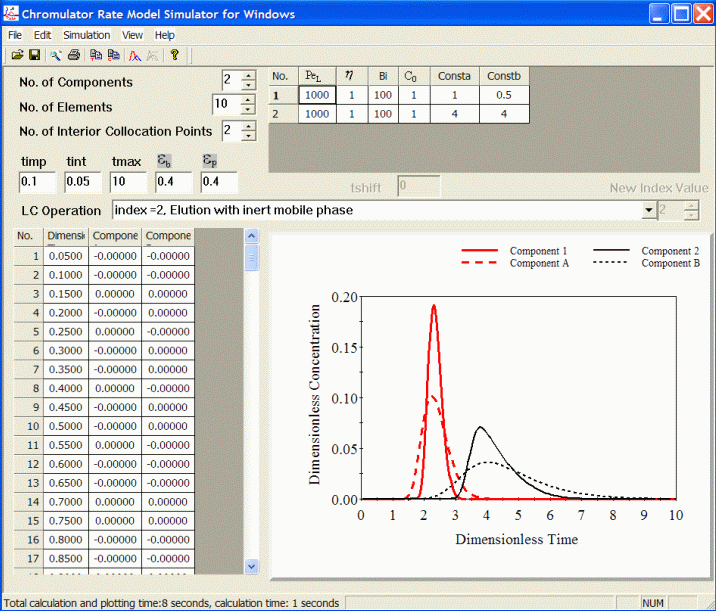Tingyue Gu's
Chromatography Simulation Home Page
(Chromulator Version 1.1 and Version 2.x)
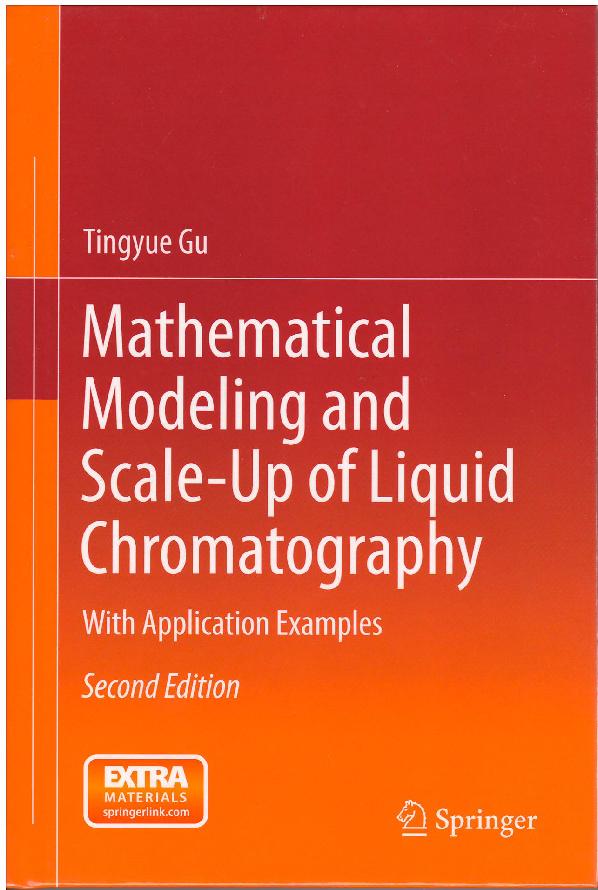
Chromulator (Chromatography Simulator) has been licensed by chemical, pharmaceutical, and biotechnology companies such as 3M, Merichem, Pfizer, Amgen, Genentech, Chiron, Wyeth BioPharma, Novo Nordisk, Millipore, Nippon Rensui, Johnson Matthey of UK, IDEC Pharmaceutical, Schering Plough Research Institute, Vertex Pharmaceuticals. It is used in product development and manufacturing with proven results. I got comments like "Your model saves us a lot of experimental time and increases our R&D productivity tremendously." Chromulator has also been licensed by a large number of academic institutions in over 32 countries. Chromulator V. 2.0 can be conveniently used to study the effects of various parameters in liquid chromatography by overlapping two sets of chromatograms. Free mass transfer parameter estimation utilities (Excel spreadsheet and soon-to-be released Windows version) are available upon request. Chromulator-IEX, a dedicated ion-exchange simulator for simple as well as complicated ion-exchange operations is available (license fee required). Dr. Tingyue Gu has in-depth knowledge in the dynamics of liquid chromatography as well as industrial experience in the bioseparations area. He is available for consulting jobs dealing with the development of chromatography media and operations, trouble-shooting and validation of existing systems, etc.
This web page discusses the use and distribution of the chromatography software covered in the book entitled "Mathematical Modeling and Scale-up of Liquid Chromatography with Application Examples (2nd Edition)" by Tingyue Gu, Springer Verlag, Berlin-New York, 2015. The original (1st edition) was published in 1995. The 2nd edition (217 pages total, 76% longer than the 1st edition) has much more details on how to evaluate parameters and how to use Chromulator with application examples. All the Fortran codes described in the book are available in the form of MS-DOS or Windows executables (.EXE files). They no longer use IMSL. I adopted a public domain ODE solver called DVODE solver (with permission from its authors) from http://www.netlib.org/. Chromulator executables are distributed as free software to academic users for noncommercial applications. Commercial applications of Chromulator require a fee (see below).
Chromulator runs on today's personal computers in a fraction of a second or just a few seconds for typical simulation runs. Comments regarding the isotherm units used in Chromulator are here. A small utility (Windows version) that I wrote to calculate total peak area (area under a concentration vs. time curve). Download here.
Chromulator-IEX software for ion-exchange
information is here Chromulator-IEX is not included in the
free academic edition of Chromulator. E-mail me to find out how to get it by
paying a licensing fee to Ohio University Foundation or through a sponsored research agreement.
Download Chromulator software: Chromulator 2.x Academic Edition. Password required for installation. Please fill out copyright agreement below. Chromulator 2.2 fixed the Gradient simulator Index input field (deleted because it is not needed for the simulator) confusion in Version 2.1. Employees of commercial companies must use the commercial edition that requires a license fee.
The following papers contain useful information on the evaluation of
parameters for the models:
1. T. Gu, K.-H. Hsu and M.-J. Syu, Scale-Up of
Affinity Chromatography for Purification of Enzymes and Other Proteins, Enzyme
and Microbial Technology, 33, 433-437 (2003) (PDF file)
2. Z. Li, Y. Gu and T. Gu, "Mathematical Modeling
and Scale-Up of Size Exclusion Chromatography." Biochemical
Engineering J., 2, 145-155 (1998). (PDF file, 308KB)
3. T. Gu and Y. Zheng, "A Study of Scale-Up of
Reversed-Phase Liquid Chromatography." Separation and
Purification Technology, 15, 41-58 (1999). (PDF file, 954 KB)
The figure on the left below (from Li et al., 1998) shows an example of a
priori prediction in low-pressure preparative size exclusion
chromatography. The figure below on the right (from
Gu et al, 2003) shows an example for low-pressure preparative affinity
chromatography. The solid and dashed lines in the figure are a priori
predictions from AFFINITY simulator. The loading, washing and elution stages
are predicted by simulation accurately. Chromulator seems well suited for the
simulation of low pressure columns with considerable mass transfer effects.
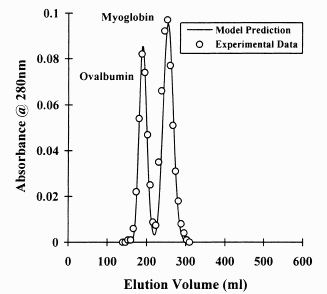
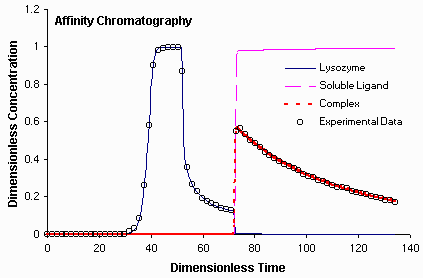
The example below (from Gu and Zheng, 1999) is for
reverse-phase gradient elution of human growth hormone and its analog on a C4
high pressure preparative column.
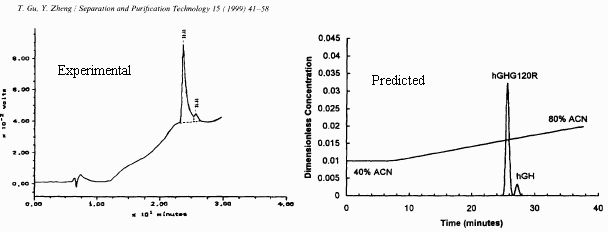
Experimental chromatogram and predicted dimensionless concentration profiles
are compared in the figures below for gradient elution of four proteins using
hydrophobic interaction chromatography (high pressure) (Truei,
Y.-H., Gu, T., G.-J. Tsai, and G. T. Tsao,
"Large-Scale Gradient Elution Chromatography," in Advances in
Biochemical Engineering/Biotechnology, Vol. 47, Springer-Verlag,
New York, 1992) (PDF
file).
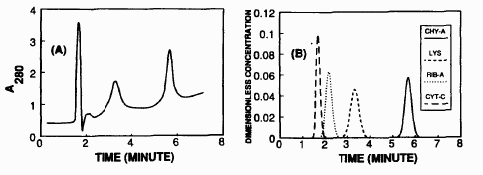
The following packages are available:
- Rate.exe
This simulator can be used to simulate isocratic elution using Langmuir isotherm or the ion-exchange type stoichiometic isotherm. Step change in mobile phase is also allowed. Mobile phase can contain a modifier. Displacement can use a reversed flow direction.
- Kinetic.exe
Instead of using Langmuir isotherm, the second-order kinetics is used. This simulator can also be used to simulate size-exclusion chromatography.
- Gradient.exe
This simulator can be used to simulate gradient elution. It uses the eluite-modulator relationship proposed by Melander, et. al. Different kinds of gradient can be used: Linear, nonlinear or stepwise.
- Affinity.exe
This software simulates the three stages (loading, wash and elution) in affinity chromatography. Elution can use an inhibitor.
- Raterfc.exe
This is the same as Rate.exe, except that it is for Radial Flow Chromatography (RFC).
- RateCored.exe
It is similar to Rate.exe, except that the packing particles are cored beads (a.k.a. pellicular beads with an inert core). This simulator became available in Chromulator Version 2.1.
It is beneficial for the understanding of the
software if read my chromatography modeling book or my publications dealing with
chromatography modeling. The software source codes can be modified to
accommodate different initial concentration conditions inside the column,
different feed profiles at the column inlet and different isotherms. Here is a document (in Adobe Acrobat format) explaining
how to change the Fortran source code RATE.FOR for
Rate.exe. All the source codes can be modified (by adding a few print
statements) to output concentration profiles inside the column which show the
peak migration patterns. The figure below shows the concentration profiles
inside the column bulk-fluid phase. It corresponds to the simulated
chromatogram at the top of this web page. The faster peak (component 1) has
larger peak areas because it has fewer molecules absorbed in the stationary
phase compared to component 1. The downloadable demo package (Windows version 1.1)
above contains the simulator that was used for the figure.
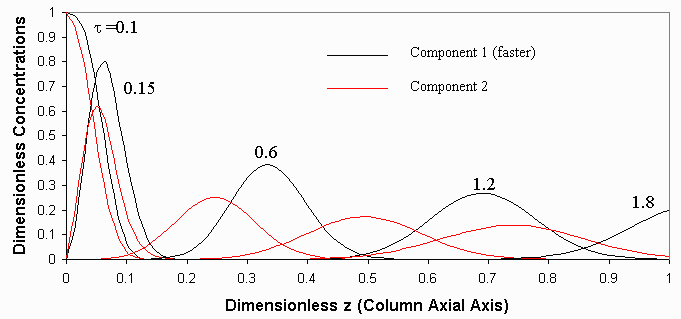
Chromulator is free for academic uses. To obtain the software, please fill out the copyright agreement below. For commercial uses, a license fee is required. Researchers from commercial companies are not eligible for free software. Academic users wishing to obtain source codes in addition to free executables will be treated as commercial buyers. However, discounts may be offered through negotiations.
---------------------- CUT HERE
------------------------
*** Copyright Agreement for Chromulator Version 2.x Software (Free Academic
Version)***
1. The user agrees not to release the software to anyone outside his/her research group, and further agrees not to use the software for commercial purposes without paying a licensing fee.
2. The user agrees to mention that the software was developed by Tingyue Gu in publications produced with the help of the software. The software is provided "AS IS," and the author makes no warranties, expressed or implied.
********** End of Copyright Agreement **********
I hereby certify that I agree to the Copyright
Agreement above.
Signature and date:
Name and job title:
Official web page showing e-mail address and job title:
Work Address:
Phone and e-mail:
Please download Chromulator 2.x (Academic Edition). Run it to get your ID number. This is a number such as -330 or 150 and so on. Do not skip the negative sign if it is there.
Windows 7/8/10/11 installation: You must run the installation file as the administrator. Just right click on the installation .exe file and then choose Run as administrator. Another way is to install Chromulator in Safe Mode. (Uninstallation can be done using the two methods as well.)
My PC's ID number shown by Chromulator is ________
(needed to create a password for a successful installation)
I listed an official web link that verifies my title and e-mail address __Yes
---------------------- CUT HERE ------------------------
(A graduate student cannot
request the software. His/her advisor must sign the copyright
agreement. An undergraduate is not eligible to get the software. Any obviously unqualified requests will be treated as spam.)
Request of free Academic
Edition without a copyright form will not be honored. If you do not qualify for
the free academic version, please do not waste time by filling out this form.
It will be ignored. If you miss the
negative sign in the Group ID number when it exists, your password will not
work.
Please do not ask me
questions about how to run the software unless you have read the 2nd
edition of my LC simulation book (see above). The book explains the simulators
and shows various examples including parameter calculations.
Please e-mail the Copyright Agreement to gu@ohio.edu.
Thank you for your interest.
